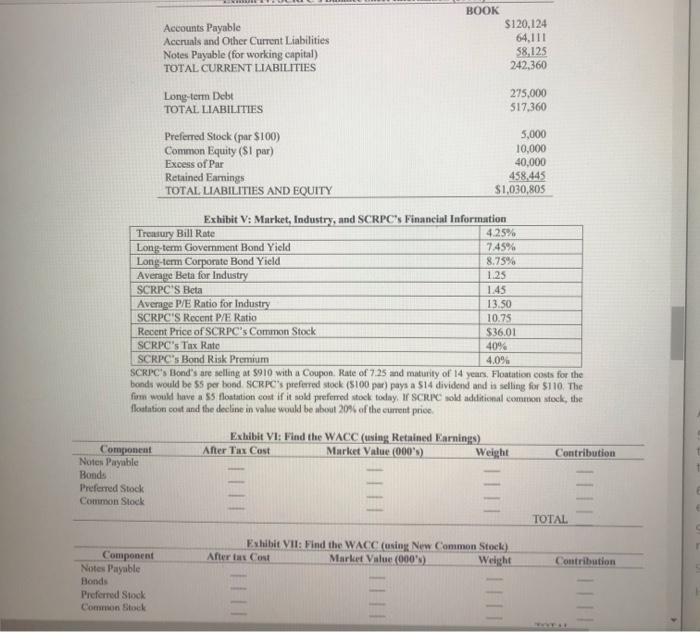Answered step by step
Verified Expert Solution
Question
1 Approved Answer
Please help answer 5,6, and 9. Exhibit I: Excerpts from Breez's Notes from His Cost of Capital Research 1. The cost of capital is really
Please help answer 5,6, and 9. 


Exhibit I: Excerpts from Breez's Notes from His Cost of Capital Research 1. The cost of capital is really the required rate of retum or hurdle rate that a firm should use to evaluate capital budgeting projects of average risk. 2. The cost of capital is a weighted average of the required return for each financing source. The weights should be based on market values and should be representative of the firm's optimal capital mix 3. All debt should not be included. Spontaneous sources like accruals and accounts payable should not be counted. Notes payuble should only be included if the fimm is using bank loans as a permanent source of long-term financing Exhibit II: Historical Estimates of Yearly Returns on Certain Investments: 1926 - 2004 Investment Arithmetic Return Geometrie Return Standard Deviation Common Stocks 12.39% 10.43% 20.32 Long-term Government Bonds 5.82% 5.44% 9.30 T-Bills 3.76% 3.72% 3.14 Inflation 3.12% 3.04% 4.32 Historic Equity Premium (Gov. Bonds) 6.57% 4.99% Historic Equity Premium (Gov. Bills) 8.63% 6.71% Source: Ibbotson Associates, Stocks, Bonds, Bills, and Inflation, Valuation Edition, 2006 Yearbook. (%) Year 2007 2008 2009 2010 2011 2012 2013 Projected Exhibit III: SCRPC's EPS and DPS Information EPS Change (%) $1.72 $1.84 3.98 $2.85 54.89 $3.25 14.04 $3.12 -4.00 $3.15 0.96 $3.35 6.35 DPS $0.92 $0.96 $1.01 $1.06 $1.10 $1.16 $1.22 4.34 5.50 4.95 3.77 5.45 5.17 BOOK Accounts Payable Accruals and Other Current Liabilities Notes Payable (for working capital) TOTAL CURRENT LIABILITIES $120,124 64,111 58,125 242,360 Long-term Debt TOTAL LIABILITIES 275,000 517,360 Preferred Stock (par S100) Common Equity ($1 par) Excess of Par Retained Earnings TOTAL LIABILITIES AND EQUITY 5,000 10,000 40,000 458,445 $1,030,805 1.45 Exhibit V: Market, Industry, and SCRPC's Financial Information Trentury Bill Rate 4.25% Long-term Government Bond Yield 7.45% Long-term Corporate Bond Yield 8.75% Average Beta for Industry 1.25 SCRPC'S Beta Average P/E Ratio for Industry 13.50 SCRPC'S Recent P/E Ratio 10.75 Recent Price of SCRPC's Common Stock $36.01 SCRPC's Tax Rate 40% SCRPC's Bond Risk Premium 4.0% SCRPC's Bond's are selling a $910 with a Coupon Rate of 7.25 and maturity of 14 years, Floatation costs for the bonds would be 55 per bond. SCRPC's preferred stock (5100 par pays a 514 dividend and is selling for $110. The form would have a 55 flotation cont if it sold preferred stock today. I SCRIC soldaditional common stock, the flotation cost and the decline in value would be about 20% of the current price Exhibit VI: Find the WACC (using Retained Earnings) After Tax Cost Market Value (000's) Weight Contribution Component Notes Payable Bonds Preferred Stock Common Stock TOTAL Exhibit VII: Find the WACC (using New Common Stock) After a Cost Market Value (000') Weight Contribution Component Notes Payable Bonds Preferred Stock Common Stock S. 6. 7 Calculate SCRPC's cost of capital when retained earnings is the source of common stock financing and the Gordon Model estimate is used. Use current market values of the financial instruments to determine the components weights (see Exhibit VI). What is SCRPC's cost of capital when the firm has to issue new common stock and the Gordon Model estimate is used? (See Exhibit VII). Calculate the Break Point that is when the firm while maintaining its exact optimal structure would have to start issuing new common stock for additional capital. The equation to find the Break Point is: Break Point - Retained Earnings for the Period/Weight of Common Stock Draw a graph representing the firms' Marginal Cost of Capital Label the vertical line dollars and name the horizontal line as interest rate. The graph should illustrate SCRPC's cost of capital Should market values or book values be used in the estimation of a firm's cost of capital. Defend your recommendation deht yet in many instances the yield to the bond holder is higher 8. 9 


Step by Step Solution
There are 3 Steps involved in it
Step: 1

Get Instant Access to Expert-Tailored Solutions
See step-by-step solutions with expert insights and AI powered tools for academic success
Step: 2

Step: 3

Ace Your Homework with AI
Get the answers you need in no time with our AI-driven, step-by-step assistance
Get Started


